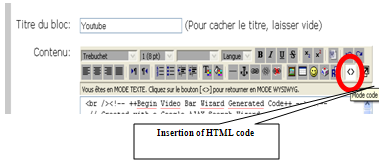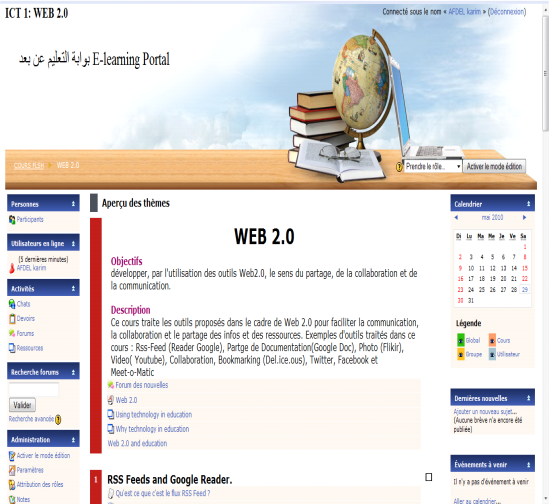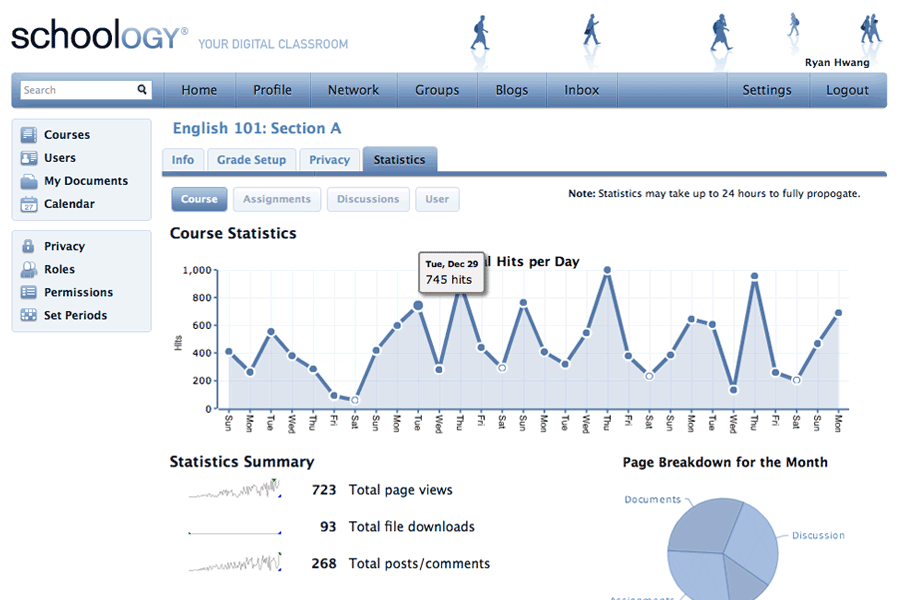Mchichi Tarik , Afdel Karim
Systems Laboratory Vision , Ibnou Zohr University Agadir, Morocco
Correspondence to: Mchichi Tarik , Systems Laboratory Vision , Ibnou Zohr University Agadir, Morocco.
| Email: |  |
Copyright © 2012 Scientific & Academic Publishing. All Rights Reserved.
Abstract
Nowadays, the web 2.0 is becoming the preferred environment for communication, collaboration and sharing especially among youth population. Web 2 tools are handy, simpler to deploy, free or not expensive and ready to be used in different contexts. This pushes many actors in the world of education to study the possible ways for applying these technologies in the educational field. Learning Management Systems as Moodle, is an example of facilitating the integration of these tools. The main aim of this is to enrich the learning environment, to facilitate the learning process, to remedy the student's isolation problem and especially to relieve the education platform by adopting an appropriate policy of use. However, our vision, first and foremost focuses on “teaching” and prevents teachers from getting lost with technology by only delegating just the management of a part of the learning to some of the web 2 tools.
Keywords:
E-Learning; Moodle , Social Networks, Google Docs, Schoology, E-Learning 2.0, Collective Intelligence
1. Introduction
The Web2.0 is a set of web user-centered design applications. These popular new services implement innovative services designed to facilitate the use and to save time, effort and energy. They allow smooth communication and enhance knowledge sharing on global scale. Many of these services could provide a favorable environment for relevant educational scenarios if some warnings and limitations of use are respected. Selecting some of these services is a necessity to avoid excesses and abuses of potential use by learners if they use them as a mean of entertainment, amusement or loss of time in classroom activities. Technically, the use of these services in a platform like Moodle shows such a great interest, since they are supported and managed externally through Web 2.0 technology. This relieves the platform by hosting and managing multiple data through the web service server. The integration of Web 2 tools can also assist this platform users and overcome the problems of isolation that can face learners in distance education. Thus, the main contribution of these tools is to push learners to participate actively, to involve the social side in distance learning and to motivate them as they practice these tools extensively and are atrated by their ergonomics, their ease of use and creating social bonds. This motivation leads to a better ownership of the platform and to promote collaboration and group work. The integration of these tools provides students with the feeling of working in a relaxed and friendly environment, full of interest belonging to the era of ICT. In our experience at Ibnou Zohr University, we have looked for ways to benefit from these technologies by using Moodle as an e-learning management system so as to bring the social side to distance learning and enhance the collaborative work between students. Thus, the main contribution of these ICT means in our platform is to enrich the content and to marry social media with an e-learning classroom management. In this article, we shall firstly show the architecture and the environment of our platform. Then we will see how we can achieve adequate learning scenarios by integrating Web 2 tools through our experience at Ibno Zohr University. Finally, we will present some statistics and results of use that testify the success of our experience with this platform.
2. Web 2.0 E-Learning Platform
2.1. The Chosen Environment and Web2.0 Tools
Our system consists essentially of a combination between the learning environment Moodle and the web2.0 tools Schoology, YouTube and Google Docs. Moodle is a free open source Course Management System (CMS), also known as a Learning Management System (LMS). It is an easy-to-use rapidly growing solution present in many educational organizations around the world [2]. Moodle gives teachers the opportunity to create a kind of virtual classroom and to present online courses. It also offers the possibility to enrich its content by adding multiple html blocks in a given course. This feature is very important since it allows incorporating different blocks of Web 2 tools using the widgets provided as shown in Figure1  | Figure 1. Integration of Web 2 tools |
To insert a block containing a widget, we first choose the web 2 tools, and then we customize it before generating the HTML code. Finally we paste the obtained code into the HTML model’s block as shown below. | Figure 2. Insertion of HTML code |
Next we show an example of how we can use these technologies through Schoology and Google docs.
2.2. Using Schoology
Schoology (www.schoology.com) was releasedcommercially in August 2009 and it is similar to Facebook. It is an online platform that marries social media and the principles of an electronic classroom management system and looks just like Facebook. The interface is thus familiar to most students and its basic features are free. Thus, Schoology enables to create assignments, events, tests and quizzes. It is easy via this tool to manage the grade book and the attendance and to track students usage and courses analytics. The social features are very familiar and close to Facebook like blogs and profile pages.
2.3. Using Google Docs
The logistic of teaching materials and course content has become easily assured by Google Docs which is a hosting service providing a suite of products where students and their teachers can work on spreadsheets, word documents, and presentations on their own or collaboratively. After dealing with the web 2 tools in our e-learning, we will now show some advantages of using these technologies and some usage statistics taken in an academic course at Ibnou Zohr University.
3. Learning Scenarios by Integrating Web 2 Tools
We have conducted a hybrid learning experience of using web2.0 tools to teach how to use social networks to the students of both the vocational B.A called “The Teaching of English as a Foreign Language and Information and Communication Technology –TEFL AND ICT for short-” and “IT master”. The English studies undergraduates had little or no knowledge of computer. However, those of the master degree were already familiar with it. We wish to discuss their involvement in the “learning social networks” course.
3.1. Learning Strategy Adopted in this Course
The strategy chosen in this course is based on aconstructivist approach to learning (Lev Vygotsky 1896-1934) which means:1. Learning is based on a process of active construction of knowledge rather than just a transmission of information Education is no longer seen as a knowledge transfer but it is a process that supports this constructivist learning 2. Learning is developed in a social interaction,specifically, with peersThis learning strategy is also based on the following principles:3. Set the general and specific objectives of the course4. Provide diverse educational resources such as video clips, images, graphs etc...in order to meet the student’s different learning patterns.5. Foster the collaborative learning by dividing the students into groups of 5 to 6, where each group will have its own working space6. Urge the learners to take notes and make summaries7. Taking tests, proposing learning situations, study cases and brainstorming activities | Figure 3. E-learning portal |
3.2. Description of Web2.0 training
This course is built on:• The description and the practical use of Web 2.0 tools that can be adapted to a distance education is reported in figure 3 and table 1.Table 1. Web2.0 tools and the educational resources
 |
| |
|
• Thinking about ways to use them in business and higher education.The following table contains the Web 2.0 tools and the educational resources used:By providing multiple forms of content production, E-learning along with Web 2.0 offers an undeniable and customizable ergonomics and a great flexibility to spark motivation, dynamism, creativity and innovation in a languages course both within a small group or a large audience, especially since most of the web 2.0 tools help to develop the reading and writing abilities thus taking into consideration the diversity of the needs and preferences of learners, and this could be an important factor for the success of the ownership.Thus, it is possible to provide not only reading and comprehension activities, but also revisions, essays and oral expression exercises which constitute the backbone of language learning. This is now possible thanks to the increasing reliability of computer networks and the improvement in the bandwidth and software and hardware infrastructure that allows us to use sharing and tele-meeting technologies such as “Openmeetings” which can be inter-operated with Moodle.
3.3. Approach of This Training Course
This course combines the classical learning at the classroom and distance learning. Students are divided into five groups and each group has a shared space.The course contains learning situations and case studies that urge learners to use web2.0 tools and also to think on how to use them in education and in the business world. Activities in asynchronous mode allow students to have the flexibility to learn “Just In Time”. Meaning that everyone, according to his own rhythm, reorganizes his learning environment, and schedules the educational resources on his convenience. In this way, students can improve their learning productivity by giving more attention and time to things that are fuzzy or unknown to them instead of lingering on the skills and knowledge already acquired.Synchronous activities are proposed in the form of educational chatting, Twitter, Skype or video footage that explains the use of Web 2.0. These tools provide the audiovisual exchange, collaboration and verbal and nonverbal communication in real time between learners. We should note that the synchronous mode, involves students in active participation while ensuring performance measurement of their progress by analyzing statistics and traceability of the various interventions recorded during the session.
4. Statistics and Results
The statistics in this article are the result of a survey of 66 students at Ibnou Zohr University. These students belong to two groups. The students of the first group are studying TEFL AND ICT. The other students are studying computer science. The aim of this study is to measure the impact of the use of web2.0 tools in learning and also to establish a better understanding of the advantages of these new learning opportunities. We found in the survey’s results that the students of the vocational B.A “TEFL AND ICT” are more interested in using Web2.0 tools. We acknowledge the relatively small number of participants involved. So, the results may not be generalized. In this survey, we urge students to evaluate the use of the web2 tools in their training in comparison with the traditional methods.
4.1. Comparison Between Web2.0 Tools in Learning with the Traditional Learning Methods
Over half of all students in this study judge that it is better to use the web2 technologies rather than just the traditional methods. The others judge these new tools as complementary. | Table 2. Comparison between Web2 tools and the traditional learning methods |
| | How do you consider these tools compared to the traditional learning methods? | | Answer | Percentage | | Complementary | 46.67% | | Similar | 3.33% | | Better | 53.33% | | Less | 3.33% |
|
|
In addition to this, 96.67% agree to use these web 2 tools in their training.
4.2. The Efficiency of Web 2 Tools in Language Learning
Over three quarters of all students said that it is very beneficial to use these tools in language learning. And nearly three quarters of all students said that they are suitable to the trainings needs. | Table 3. Judgment of the efficiency of web 2 tools in language learning |
| | | | How do you judge the efficiency of web 2 tools in language learning? | | Answer | Percentage | | Very beneficial | 76.67% | | Partially beneficial | 10.00% | | Little benefit | 10.00% | | Note at all | 0.00% | | | |
|
|
4.3. Evaluation of Group Work Using Web 2 Tools
According to this survey, 86% of the students said that the use of these tools facilitates the group’s work. Some students confirm that the logistic of teaching materials and course content has become easily assured by the platform that sends emails to the interested parties, especially when using Schoology. | Table 4. Evaluation of group work using web 2 tools |
| | Does the use of these tools facilitate group’s work? | | Answer | Percentage | | Yes | 86.67% | | Partially | 10.00% | | Not at all | 3.33% |
|
|
4.4. Fast Launch and Not Expensive
We found that the startup time is fast, and the cost is very low. Since Moodle’s interface is intuitive, simple, and very user-friendly it takes short training for users. In addition, there are many videos on YouTube explaining the use of the Web 2.0 tools that we have incorporated in our Learning Management System, namely Google docs and Schoology. The adoption of these tool by learners and their teachers was a quick profit. In addition to the fact that they are time-saving, free and save a lot of effort, there is also the pleasant aspect which makes the learning atmosphere relaxing. According to the users, they feel that Schoology is primarily a social network and sharing website. Also the notifications generated by Schoology such as email, keep learners and their teachers in touch and all updates anytime and anywhere.
4.5. Objective evaluation of students
Students judge that their evaluation is objective by using Schoology.As said above, Schoology gives the teacher the ability to track each student activity by course. It also gives the statistics of the course activity. In our case, the teacher knows the volume of the activity by the number of hits per day.  | figure 4. Statistic of use in Schoology |
5. Conclusions
In this course, we have observed that students with no computer knowledge get more involved in learning web2.0 tools and that these tools can facilitate the communication and the English language learning..We also found that the use of an E-learning management system with some suitable social networking tools allows an attractive, easy to use, low-cost, and effortless e-learning environment. This combination facilitates administrative management courses and can be used widely in the world as a solution for Universities and schools to overcome the cost of such modular e-learning solution. Finally, we introduced a few recommendations for an efficient integration of Web 2.0 tools and E-learning.
References
| [1] | T.Mchichi, K.Afdel “Web 2.0-Based E-Learning Moodle-Openmeetings Platform“ ICMCS'11 |
| [2] | T.Mchichi, K.Afdel “The use of Web 2.0 Innovations on Education and Training”” – WSEAS |
| [3] | Christine Redecker, Kirsti Ala-Mutka and Yves Punie Learning 2.0: The Impact of Web 2.0 Innovations on Education and Training in Europe |
| [4] | http://www.onlineuniversities.com/blog/2010/05/100-inspiring-ways-to-use-social-media-in-the-classroom/ (visited on february 2011). |
| [5] | World Conference on Educational Sciences 2009 :To use or not to use web 2.0 in higher education? Gabriela Grosseck |
| [6] | 100 Inspiring Ways to Use Social Media In the Classroom |
| [7] | http://www.onlineuniversities.com/blog/2010/05/100-inspiring-ways-to-use-social-media-in-the-classroom/ |
| [8] | 100-inspiring-ways-to-use-social-media-in-the-classroom/ http://www.onlineuniversities.com/blog/2010/05/ (visited on February 2012). |
| [9] | The Design and Implement of Knowledge Building |
| [10] | Classroom Based on Web2.0 Xinyu Zhang1 and Zhigang Wang2 |
| [11] | Google For Educators - Google Docs |
| [12] | http://www.google.com/edu/teachers/ (visited on February 2012) |
| [13] | www.google.com/educators/p_docs.html(visited on February 2012). |
| [14] | Palo Alto Schools Just Bet Big On Schoology/(visited on February 2012) |
| [15] | http://edudemic.com/2012/01/schoology-revisited/ |
| [16] | http://edudemic.com/2012/01/schoology-revisited/(visited on February 2012) |
| [17] | www.moodle.org (visited on February 2012). |
| [18] | www.schoology.com(visited on February 2012). |
| [19] | The Design and Implement of Knowledge Building |
| [20] | Classroom Based on Web2.0 Xinyu Zhang1 and Zhigang Wang2 |





 Abstract
Abstract Reference
Reference Full-Text PDF
Full-Text PDF Full-Text HTML
Full-Text HTML